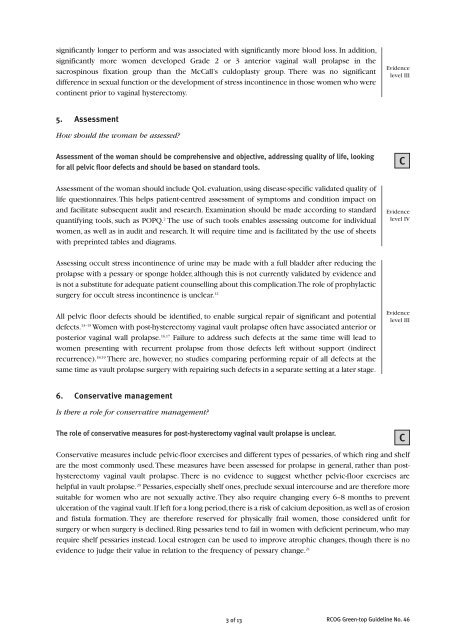The Management of Post Hysterectomy Vaginal Vault Prolapse ...
The Management of Post Hysterectomy Vaginal Vault Prolapse ...
The Management of Post Hysterectomy Vaginal Vault Prolapse ...
Create successful ePaper yourself
Turn your PDF publications into a flip-book with our unique Google optimized e-Paper software.
significantly longer to perform and was associated with significantly more blood loss. In addition,significantly more women developed Grade 2 or 3 anterior vaginal wall prolapse in thesacrospinous fixation group than the McCall’s culdoplasty group. <strong>The</strong>re was no significantdifference in sexual function or the development <strong>of</strong> stress incontinence in those women who werecontinent prior to vaginal hysterectomy.Evidencelevel III5. AssessmentHow should the woman be assessed?Assessment <strong>of</strong> the woman should be comprehensive and objective, addressing quality <strong>of</strong> life, lookingfor all pelvic floor defects and should be based on standard tools.Assessment <strong>of</strong> the woman should include QoL evaluation, using disease-specific validated quality <strong>of</strong>life questionnaires. This helps patient-centred assessment <strong>of</strong> symptoms and condition impact onand facilitate subsequent audit and research. Examination should be made according to standardquantifying tools, such as POPQ. 2 <strong>The</strong> use <strong>of</strong> such tools enables assessing outcome for individualwomen, as well as in audit and research. It will require time and is facilitated by the use <strong>of</strong> sheetswith preprinted tables and diagrams.CEvidencelevel IVAssessing occult stress incontinence <strong>of</strong> urine may be made with a full bladder after reducing theprolapse with a pessary or sponge holder, although this is not currently validated by evidence andis not a substitute for adequate patient counselling about this complication. <strong>The</strong> role <strong>of</strong> prophylacticsurgery for occult stress incontinence is unclear. 12All pelvic floor defects should be identified, to enable surgical repair <strong>of</strong> significant and potentialdefects. 13–15 Women with post-hysterectomy vaginal vault prolapse <strong>of</strong>ten have associated anterior orposterior vaginal wall prolapse. 16,17 Failure to address such defects at the same time will lead towomen presenting with recurrent prolapse from those defects left without support (indirectrecurrence). 18,19 <strong>The</strong>re are, however, no studies comparing performing repair <strong>of</strong> all defects at thesame time as vault prolapse surgery with repairing such defects in a separate setting at a later stage.Evidencelevel III6. Conservative managementIs there a role for conservative management?<strong>The</strong> role <strong>of</strong> conservative measures for post-hysterectomy vaginal vault prolapse is unclear.Conservative measures include pelvic-floor exercises and different types <strong>of</strong> pessaries, <strong>of</strong> which ring and shelfare the most commonly used. <strong>The</strong>se measures have been assessed for prolapse in general, rather than posthysterectomyvaginal vault prolapse. <strong>The</strong>re is no evidence to suggest whether pelvic-floor exercises arehelpful in vault prolapse. 20 Pessaries, especially shelf ones, preclude sexual intercourse and are therefore moresuitable for women who are not sexually active. <strong>The</strong>y also require changing every 6–8 months to preventulceration <strong>of</strong> the vaginal vault. If left for a long period, there is a risk <strong>of</strong> calcium deposition, as well as <strong>of</strong> erosionand fistula formation. <strong>The</strong>y are therefore reserved for physically frail women, those considered unfit forsurgery or when surgery is declined. Ring pessaries tend to fail in women with deficient perineum, who mayrequire shelf pessaries instead. Local estrogen can be used to improve atrophic changes, though there is noevidence to judge their value in relation to the frequency <strong>of</strong> pessary change. 21C3 <strong>of</strong> 13 RCOG Green-top Guideline No. 46
















